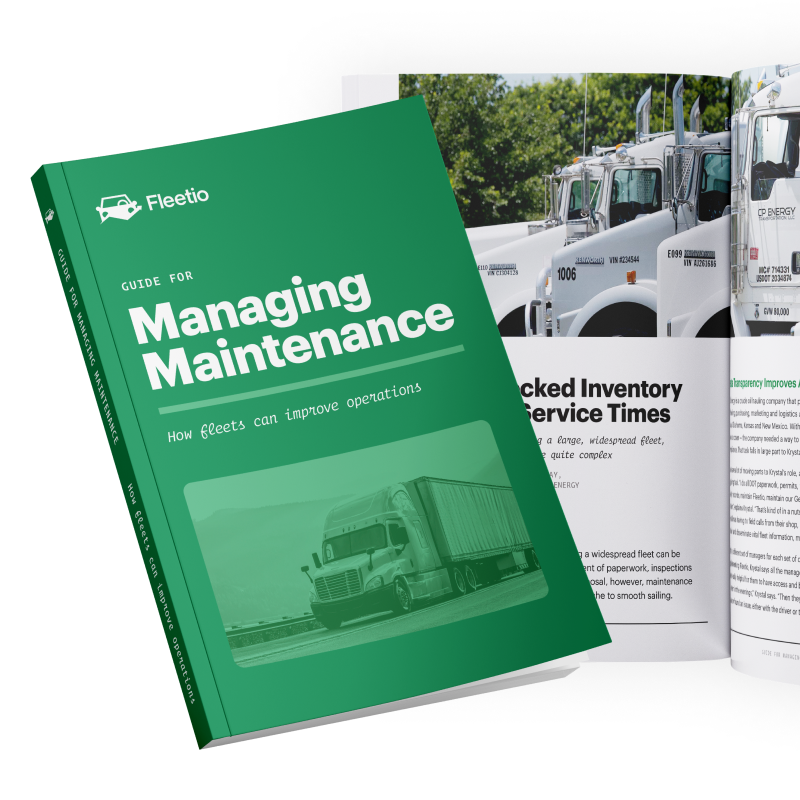2025 Fleet Industry Trends
As we near the end of the year, we’re taking a look back at fleet industry trends predicted for 2024 to see what came to pass, as well as what missed the mark and why. With a better understanding of how 2024 panned out, we’ll take a more nuanced look at what to expect in 2025.
Jan 11, 2025
14 min read

Boy, oh boy, has this year been something else. Back in February, we covered what this election year could mean for fleets, but it was darn near impossible to see the twists and turns that came down the line. Now, 2024 is nearing its end, Trump will be back in office in 2025 and industry publications are already putting out their forecasts.
Before we dive into our industry trends for 2025, let’s take a look back at some of our 2024 predictions to see how they panned out.
Jump to a topic
2024 Retrospective
Our trends for this year revolved around three major categories: economic instability, fallout from escalating wars and increased emissions regulations.
In regards to economic instability, that was surely something to contend with. In the past several months, however, central banks around the world have been cutting interest rates, signaling an easing of inflation. After the election and a second Fed rate cut, the U.S.’s main stock market index reached an all-time high, according to Trading Economics. The Fed held the rate at 5.3 percent from July 2023 to September 2024, and it now sits at roughly 4.5 to 4.75 percent. While we dodged a full-blown recession, many people across the country are dealing with an uncomfortably high cost of living — and doing business.
Another economic challenge we highlighted was the potential for decreased fiscal spending. While that’s something that could have negatively impacted government fleets — and government-funded initiatives — for a while, it would have worked toward lowering the national deficit (currently sitting at $1.83T) and curbing the national debt (currently sitting at $35.46T). Instead, fiscal spending increased, an inflationary move hurting both consumers and business owners alike. “As the federal debt mounts, the government will spend more of its budget on interest costs, increasingly crowding out public investments,” according to the Peter G. Peterson Foundation. “As more federal resources are diverted to interest payments, there will be less available to invest in areas that are important for economic growth.”
In terms of fallout from escalating wars, we did see that. Billions of U.S. dollars going to fund Israel and Ukraine helped continue inflation in the U.S., and conflict affected major ports in the Middle East, disrupting supply chains.
And, finally, multiple emissions regulations indeed went into effect in 2024, with more ambitious targets put in place for the future. “On March 20, 2024, EPA announced new, more protective final standards to further reduce harmful air pollutant emissions from light-duty and medium-duty vehicles starting with model year 2027. The final rule builds upon EPA’s standards for federal greenhouse gas emissions [...] for passenger cars and light trucks for model years 2023 through 2026, established in 2021,” according to the U.S. EPA.
“On March 29, 2024, EPA issued a final rule to revise existing standards to reduce greenhouse gas emissions from heavy-duty vehicles in model year 2027 and set new, more stringent standards for model years 2028 through 2032.”
In short, 2024 trends were hit-and-miss, although with some similarly-predicted outcomes. But hey, who can see the future, am I right?
2025 Trends
Similar to last year’s list, we’ll be looking at trends on a broad scale and diving into how they could affect the fleet industry. More importantly, we’ll discuss steps you can take to navigate the changes these trends may represent.
Here’s a high-level peek at what we’ll be diving into:
- The potential for labor strikes: In 2024, several labor strikes took place with union members highlighting wage and technology concerns. With the ILA strike on hold until 2025, what might another round of labor strikes mean for the supply chain?
- A boom in automation advancements: Automation has been near the forefront of automotive discussions in recent years, but 2025 may be positioned as the year of scale — regarding both processes automation and autonomous vehicles.
- A new presidential administration: Trump has voiced substantive policy shifts away from what we’ve seen over the last four years. As he gears up to take the White House, what changes might his administration bring?
1. International Longshoremen’s Association Strike (The Re-strikening)
We've seen a slew of worker strikes over the past couple of years that impacted everything from entertainment and hospitality to machinists and auto workers. The UAW strike in particular caused a shortage of vehicles at dealerships, interrupted the fleet vehicle supply chain and created longer lead times for vehicle acquisitions.
Following that, we got a bit of a startle in October when the International Longshoremen’s Association (ILA) went on strike for three days. Even though it was short-lived, it did some damage. “At least 54 container ships had lined up outside the ports as the strike prevented unloading, according to Everstream Analytics, threatening shortages of anything from bananas to auto parts,” Reuters reported.
After a tentative deal was struck regarding wage increases, the strike was put on delay until January 15, 2025 as health benefits and port automation still needs to be addressed. Should the strike reignite due to negotiation failures, there is potential for long-standing economic harm depending on the length of the strike.
On top of that, the UAW has called for another strike, this time on a much larger scale in the form of a general strike that includes a collective of unions. That said, the strike isn’t slated for another few years, in 2028, when the UAW’s most recent contracts with the “Big Three” expire.
So what are the chances the ILA strike will resume? While the possibility is, of course, present, the chances of it coming to pass may be slimmer than expected. Last November, ILA President Harold Daggett met with Trump regarding the union’s issues. The union put out a memo in July, wherein Daggett explained: “We had a wonderful, productive 90-minute meeting where I expressed to President Trump the threat of automation to American workers. [...] President Trump promised to support the ILA in its opposition to automated terminals in the U.S. Mr. Trump also listened to my concerns about Federal ‘Right To Work’ laws which undermines unions and their ability to represent and fight for its membership.”
- 1/21 Update: As of January 8, the ILA and U.S. Maritime Alliance struck a tentative six-year deal to avoid port closures
Key Takeaway
Even short port strikes can create freight and trucking challenges and shortages in key fleet needs, including new vehicles and replacement parts. While that is something to keep in consideration — and make a plan for — the likelihood of the strike resuming is not high. With a potential UAW strike looming on the horizon, however, fleets might want to take steps to prepare.
Maintenance hacks straight from the pros
See how industry pros keep their fleets up and running. Download our free guide for expert insights into in-house, third-party and mixed maintenance strategies.
Get your guide2. Automation, Automation, Automation
2025 could prove the year of substantial increases in automation — both in the fleet management industry and on the road. Many fleet managers have been working to up their process automation game using fleet technologies like management software and optimization platforms. While these technologies don’t automate every process, some managers have gotten creative and found workarounds that allow them to automate processes not currently addressed in the system, which signals a growing interest in this functionality. As fleets gain more ability to automate things like work orders, inventory resupply, reports, etc., they can save time and better ensure critical issues and duties are addressed.
We can’t talk about automation without touching on autonomous vehicles (AVs). Some of the biggest hindrances for AVs are safety, investment and scale — and 2024 saw some exciting gains that may allow the industry to hit major strides in 2025. In October, Gatik AI Inc., a leader in autonomous middle mile logistics, unveiled “the scope of a comprehensive safety case assessment for its Freight-Only operations (deliveries without a human driver onboard) across North America. With this announcement, Gatik is committed to launching Freight-Only operations at scale once it satisfies the most rigorous evaluation ever performed on its autonomous driving system by independent third parties.” The company noted that its safety “assessment will encompass over 700 identified safety portfolios [that] must be completed and closed before [it] can achieve Freight-Only operations at scale.”
Investments are likewise gaining traction. According to S&P Global, “In the summer of 2024, Waymo's parent Alphabet said it would invest up to US $5 billion into the startup, which also unveiled the sixth generation of its Waymo Driver autonomous driving system. Waymo operates a fleet of nearly 800 self-driving vehicles in California and more in Phoenix [...] and it is the only one collecting fares today, though GM's Cruise fleet is also expected to do so again sooner rather than later.”
Key Takeaway
Adopting automation in fleet needs to be a well-thought-out endeavor, whether in fleet software or low level AVs (adaptive cruise control and braking, lane-keeping, etc.). Outline what types of automation functionality will best improve your fleet operations, and build from there, but avoid adopting it just for the heck of it. Determine what problem it will solve and what improvements it can provide.
3. The U.S. Under New Management
A new administration can have various — and numerous — effects on the fleet industry depending on the policies set forth and carried out, so we’re going to break this section down into two parts: sustainability and economic outlook.
Relaxed Sustainability Regulations
Back in 2020, Brookings tracked the Trump administration’s “deregulatory actions, and count[ed] 74 actions that the administration [took] to weaken environmental protection,” with a focus of tackling climate change initiatives. According to Holland & Knight, Trump is expected to expand those actions and “reverse the Biden Administration's light-duty vehicle emissions standards.” Trump’s own Agenda 47 echoes this, stating that his administration “will revive the U.S. auto industry by reversing harmful regulations [and] canceling Biden’s electric vehicle and other mandates.”
Sustainability is important to many fleets, whether because of climate worries or to appeal to climate-conscious customers, but there are concerns about meeting regulatory deadlines that seem impossible to achieve. In many places, the charging infrastructure just isn’t enough to support a high volume of EVs, and fleets operating in colder climates aren’t getting the range they need from their assets. A rollback in sustainability initiates provides fleets a better — less stressful — opportunity to plan for and enact EV adoption at a pace that suits their business and operational needs and allows them to better assess the current performance of EVs already in the fleet.
- 1/29 Update: U.S. Secretary of Transportation, Sean Duffy, has authorized actions rolling back climate-related regulations, including approving "submission of a Notice of Proposed Rulemaking to rescind the Biden-Harris Administration’s rule requiring state transportation departments to measure and establish declining targets for carbon dioxide emissions on federally supported highways"
Economic Outlook (and Potential for Reduced Operating Costs)
The state of the economy greatly impacts fleet operating costs, from fuel and maintenance to labor, customer volume and even just keeping the business’s lights on. Many things can affect the economy but, currently, inflation is the top dog. When it comes to inflation, government spending is a driving force, and illegal immigration and federal aid packages for Ukraine and Israel have played a large part in increased spending. According to Newsweek, “The FAIR study, released in March last year, documented the financial toll of illegal immigration on the U.S., taking into account factors like emergency medical care, incarcerating illegal aliens in local jails, and federal budgets that pay out billions in welfare every year, pegging the net annual cost at $150.7 billion.” The Congressional Budget Office noted that this has “cost federal and state taxpayers more than $16.2 billion.”
On the war front, the U.S. has spent upwards of “$174 billion to assist Ukraine,” according to the U.S. Government Accountability Office. Meanwhile, The Hill reports that the U.S. has also “spent more than $22 billion on fighting the conflict in the Middle East.” Not only does the government spending here drive up inflation, but the wars also negatively impact supply chains, all of which stifle economic growth.
Already in Motion
Within days of becoming President-elect, we're already getting a glimpse at which initiatives are top of mind for Trump.
Trump has been very vocal about curbing frivolous government spending, in part by creating the Department of Government Efficiency, with an ambitious goal of cutting $2T in spending, which could — while not without its complications — play a major role in reducing inflation. He’s also been vocal about closing the border and enacting mass deportations, and picking Tom Homan to tackle these issues signals his commitment to doing so. While this could prove a costly endeavor upfront that eases long term, any fleets relying on undocumented workers may run up against labor challenges.
Additionally, based on his rhetoric, policy and his last term, we can surmise he’s anti-war, as he was the first President since Jimmy Carter to have no new wars started under him — and this term, he is not only surrounding himself with prominent anti-war figures, but appointing them to his cabinet.
- 1/19 Update: A ceasefire deal was put into effect between Israel and Hamas
- 1/21 Update: Trump not sure ceasefire deal will hold
- 2/20 Update: Efforts in securing the border have resulted in a 94% reduction in illegal crossings "from the same period last year"
- 2/26 Update: D.O.G.E. initiatives have saved roughly $55B taxpayer dollars over a 37-day period, though it should be noted that this claim may not reflect true savings, which could be closer to $8B
- 2/26 Update: At a sit down in Saudi Arabia, "Moscow and Washington agreed to start working toward ending the war and improving their diplomatic and economic ties," though it should be noted that Ukraine was not a part of the previous or upcoming discussions
- 2/26 Update: Phase A of the ceasefire between Israel and Hamas is nearing completion, though negotiations for the next phase have been delayed
The Impact of Tariffs
I suppose we can’t talk about the economy without addressing the elephant in the room: the “T” word. Tariffs. Throughout the election cycle, tariffs have been touted as a tax on consumers and, when implemented poorly, they surely can be. They can cause supply chain disruptions and hike up prices of both domestically and internationally sourced goods. On the other hand, tariffs can be a useful bargaining chip that incentivizes other countries to purchase U.S. goods as a way to avoid the tariffs. They can also help incentivize onshoring or near-shoring of manufacturing — especially when applied in conjunction with cutting corporate taxes — which can lead to higher freight volumes and domestic economic growth.
- 2/26 Update: In early February, Trump signed executive orders introducing tariffs against nearly all goods from Canada, Mexico and China. The tariffs on Canada and Mexico have been delayed to March 4 while negotiations continue — the tariffs on China went into effect on February 4. As part of the negotiations, Canada plans to implement a $1.3B border plan that was announced in December 2024 and the addition of 10,000 National Guard members at the Southern border. Additionally, some companies have announced plans to invest in new U.S. manufacturing plants as a response
Key Takeaway
Tackling inflation will undoubtedly help fleets reduce operational costs, and less war and unnecessary government spending can help spur economic growth. There are a couple other things that can take that cost reduction a step further, though. Trump’s policies around investing in U.S. energy independence should, similar to his last term, reduce fuel costs. Plus, the U.N. is already discussing negotiating buying more LNG from the U.S. — as opposed to from Russia — to avoid Trump’s tariff plan, which is beneficial to the U.S. economy.
New updates keep your fleet rollin’
From on-site fuel integrations to enhanced reporting, our latest updates are designed to simplify fleet management and drive efficiency.
Check out the latest
Senior Fleet Content Specialist
As a Senior Fleet Content Specialist at Fleetio, Rachael Plant uses her near decade of industry experience to craft practical content aimed at helping fleet professionals tackle everyday challenges with confidence.
LinkedIn|View articles by Rachael PlantReady to get started?
Join thousands of satisfied customers using Fleetio
Questions? Call us at 1-800-975-5304

